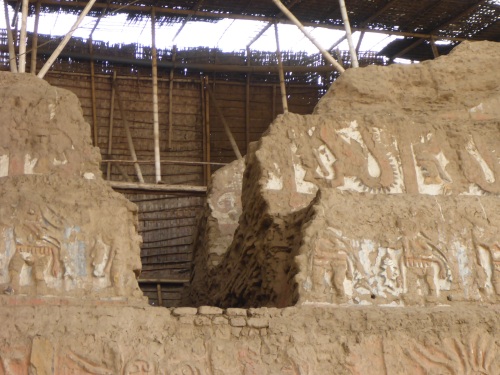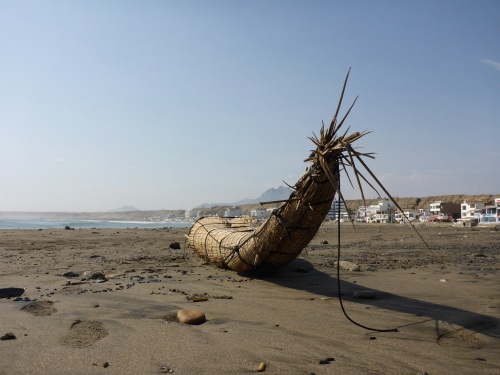Anne has mentioned that she likes it when I choose a hotel, she looks for price, location and reviews, I pick from the GPS list and hope for the best, which for some strange reason usually is. Today my pick turns out out to be a beautiful Hotel Libertador on the Plaza de Armis in Trujillo, a wonderfully preserved square and surrounding buildings. (Sounds familar?)
When I commented some time ago on the cultural similarities we encountered from time to time travelling through the ‘Stans’, Iran and India, all countries with intertwined histories at different points in time, little did I think that some of those similarities would appear in Peru. I am referring to the Spanish architectural influence, in turn influenced by the Moors, with their roots in North Africa again having come from further east. It’s a long connection and those more knowledgeable than me may find flaws in my thinking, but it is interesting to see how far across the world cultures are connected.
While Peru is famous for its Inca culture and of course Machu Picchu, many older and more influential cultures existed which do not have the same public exposure as the Inca’s. The Northern Peruvian coast was inhabited by two civilisations between approximately AD 100 and the Inca conquest in AD 1470. The Moche (AD 100 to AD 650 approx.) and Chimú (AD 650 approx. to AD 1470) both occupied roughly the same boundaries and there is conjecture that the move from one civilisation to the other was triggered by the an exceptionally long El Nino, some 60 years of flood and drought, and was due to internal struggles over scarce resources, and the loss of confidence in the gods and by association loss of credibility in political and religious leaders.
The Moche developed the Huaca de la Luna (“Temple/Shrine of the Moon”) over a period of five hundred years. The construction is unusual in that every hundred years or so, the temple was completely built over, creating a new layer of similar design to the old, with tombs of important leaders sandwiched between layers. It is interesting to note that the design of each layer is stepped inwards from the outside and stepped outwards from the inside. Hope that makes sense! This temple was not rediscovered until the early 1990’s by students looking at the nearby ruins of the nearby town.
The nature of the construction with adobe means that heavy rain erodes the top layer making it indistinguishable from the surrounding countryside especially when covered in sand dunes. When excavation does take place, protection from the ravages of the elements is essential for any long term survival. This seems to take the form of galvanised roofing in some places on the sites or a newly applied extra layer of mud that seems to have some cement and gravel included.
Five kilometres from Trujillo is Chan Chan the largest adobe (mud) city in the world. Built by the Chimor people (Chimú civilisation). Chan Chan was built around AD 850, covering over 20 square kilometres with a population of 30,000 people, Chan Chan was comparable to any major city around the world of its time. The city was only uncovered in the 1970 and yes it’s another UNESCO World Heritage Site. Some have commented that we seem to be visiting all UNESCO’s world heritage sites but no there are still one or two (hundred or thousand) to see yet.
The Moche and Chimú cultures had a couple of modern day features, The culture worshipped the moon rather than the more usual sun worship. As the moon is considered female, thus the majority of the sacrifices were male. An early form of equality! With the choice of the moon to worship, calendars were based on 28 days and years on 13 months. The other modern feature in the Chimú palace uncovered is the fish motifs in the bases of palace walls in rooms and passageways which indicate which way to the exit, by following the fish symbols. A ancient ‘EXIT’ signage system.
While touring Chan Chan and the partially restored palace, we could hear the sound of the sea, only two kilometres away which was to be our next destination. We wanted to see the reed canoes at nearby Huanchaco. The construction is traditional, but they are now stuffed with expanded polystyrene for modern day buoyancy.
Museo Tumbas Reales de Sipán (Museum of the royal tombs of Sipán) is a modern museum in Lambayeque a northern Peruvian town which displays the treasures found in the royal tombs. What a breathtaking display, this really needs more publicity for people visit. No pictures were allowed inside, but here is the link http://www.museotumbasrealessipan.pe It does need flashplayer so will not work from an ipad.
What makes this collection so special is that the treasures remained undiscovered until very recently and therefore were never looted unlike the Huaca de la Luna. Complete tombs with all the offerings to the gods for a good afterlife have been left intact for hundreds of years. The quality of the jewellery and pottery and designs have to be seen to be truly appreciated.
– Anthony


















Fascinating !!
LikeLike
It is very interesting, so much history that we knew nothing about.
LikeLike
Very interesting – thank you!
LikeLike
We know so little about many cultures histories, I am sure we will find out more as we progress north.
LikeLike
You illustrate really well it is perhaps only when you get into a country and start to look below the surface you get a better appreciation of what the history of the culture can bring. I had never thought that South America beyond Inca and Aztec would have this rich cultural past, however, if you think about it this perspective in itself has got to be wrong. Big thanks for this blog, I will now go and dive deep on the Internet for some of your references.
LikeLike
When we first went to Peru in 1988 we visited the national history museum. The Incas and Spanish occupied the last room of the museum together! There is so much history in the region going back many thousands of years that filled the rest of the museum. So much to see and learn, will be interested to see what you have learnt by the time we return.
LikeLike
Not only do your armchair travellers get a geography lesson but also a history one. The Moche culture made me smile, bien sûr, moche meaning “ugly” in French. Now I’m going to the museum website; tku for that. xx
LikeLike
I am sure that they did not consider the French language when they named themselves. It is interesting to see across languages which words have similar roots and those which are just co incidence
LikeLike
Thanks for sharing the history, it is fascinating that the rebuilding happened more than once. The face of the ‘Exterminator’ God looks like the face of the Chinese dragon to me. I wonder if there is a link? Must have taken a fair amount of balance and skill to paddle a read boat as it appears to cut off at the back xx
LikeLike